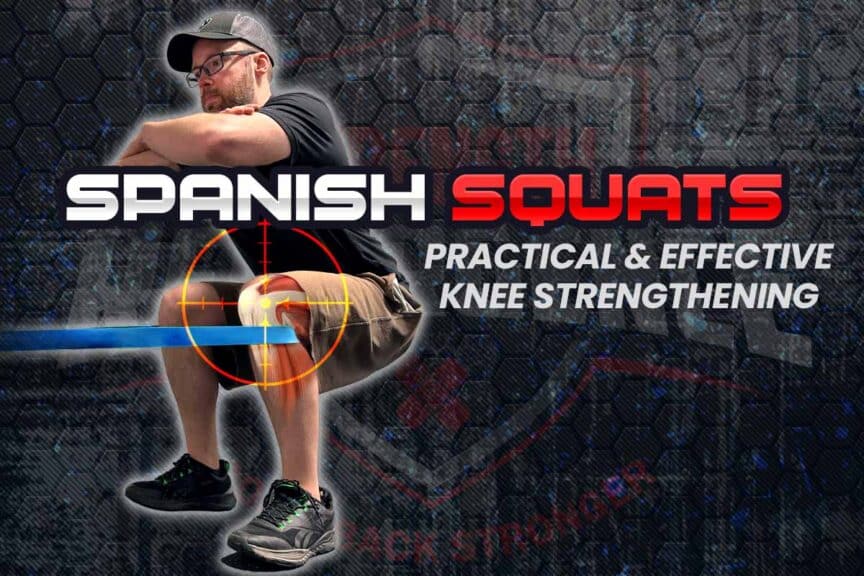There’s something unique about the Spanish squat that can be a game-changer for improving the health of your knee tendons and thigh muscles; whether you’ve got healthy knees or knees that have some mild aches and pains, you can get some outstanding benefits with the simple principles that I’ll cover in this article.
Specifically, you’ll learn why the Spanish Squat can be so effective when treating patellar and quadriceps tendinosis, how to implement optimal loading parameters and a few other concepts that geeks like me love to share with others who want to get the most out of their injury rehabilitation or prehabilitation training.
So, let’s get after it and learn all about the Spanish Squat!
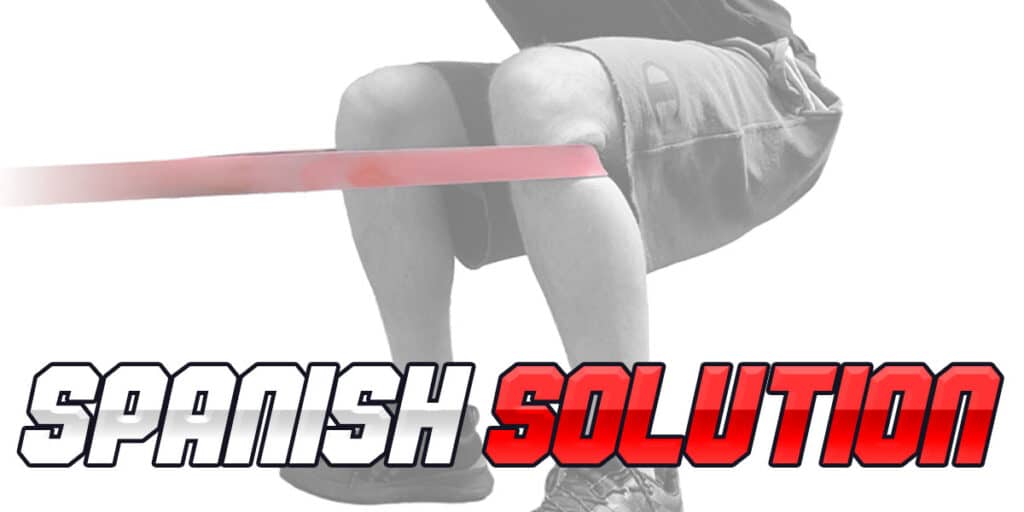
A small request: If you find this article to be helpful, or you appreciate any of the content on my site, please consider sharing it on social media and with your friends to help spread the word—it’s truly appreciated!
Knee pain: common causes
Knees are great until they stop working properly. You never realize how much you use these things until they become painful. I would certainty know, as I not only see it all the time with my patients in the clinic, but I myself have had bouts of nasty knee pain on and off over the years.
And to be clear, there are a lot of reasons as to why knees can become painful; it all comes down to the specific tissues that have been affected. But in this article, I’m focusing on one particular — and all too common — knee issue, which is tendinosis ( sometimes called tendinopathy).
One very common reason knees often become painful, especially when we’re only in our second, third, or fourth decade of life, is due to a lack of health in the tendons just above and below the kneecap, which, as I just stated is the focus of this blog post.
Related article: Reverse Nordics and Knee Health: What You Must Understand
Without going into overt amounts of detail, these tendons can become sore and painful, either from insufficient or too much physical activity. Thankfully, when these situations arise, we can often use an exercise like the Spanish squat to get things back on track.
“Tendinitis isn’t nearly as prevalent as we once believed it to be, and research has found that tendinosis is much more common.”
Even better, we can also use this exercise to keep your knees strong and healthy so that you don’t ever have to experience this type of annoying tendon condition. I feel it’s also worth knowing that some research has looked at the effects of this exercise in terms of what it can produce for the unique demand of the tissues around the knee, so we’re not just flying on a whim here and merely hoping that it can do some good things for the knees.
The breakdown: What’s going on here?
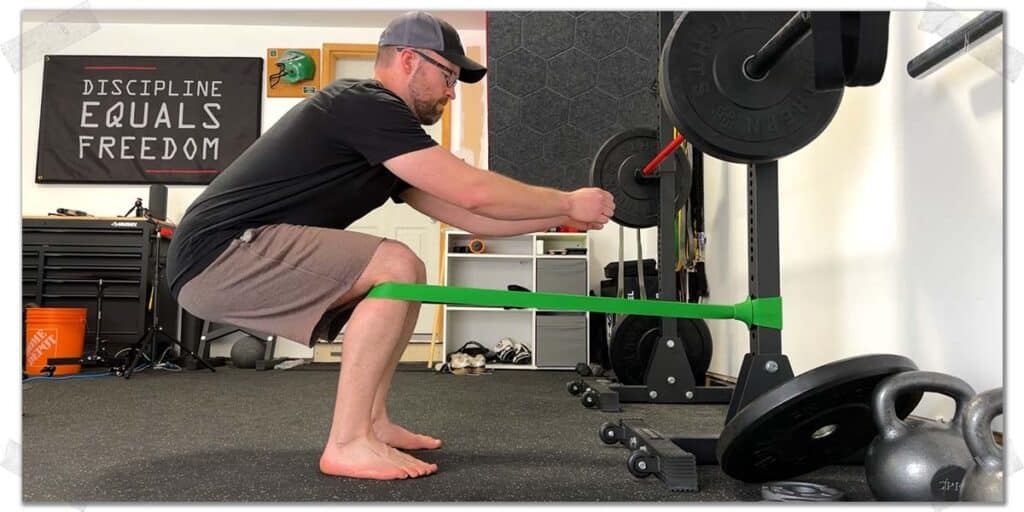
Let’s start with a basic rundown of what’s taking place here for making this exercise so unique and effective for your knees. A bit of education truly goes a long way toward ensuring a better experience and better outcomes with this exercise.
I’m aware some of you are looking for short articles, and there are plenty of “how to perform the Spanish squat” articles out there without the education component. However, I construct my articles and content for those who are truly interested in learning not only some outstanding exercises but also the basic science behind them.
So, let’s do a basic breakdown, and then I’ll spill the secret sauce about how all of this translates to optimizing knee health and how we can get the most out of this exercise.
Differences: Traditional vs Spanish Squat
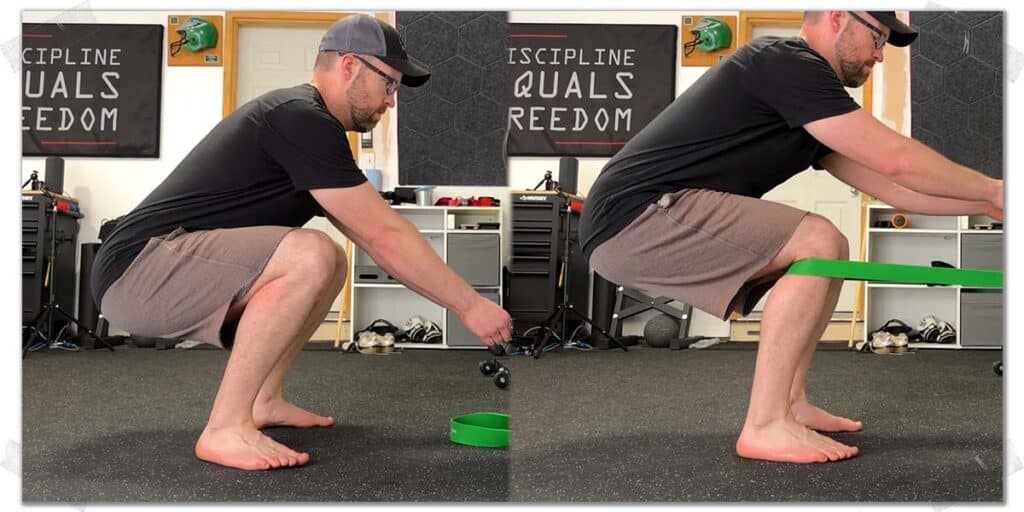
If we compare a traditional squat to a Spanish squat, you’ll likely notice a few differences. For starters, the body is in a very different position in the former, and this difference drastically changes the demands that the tendons around the knee and the quadriceps muscles experience.
Ultimately, this is all about biomechanics, which I’m certainly not going to get overly specific within a blog post, partly because I’m just not the greatest with math and numbers. (Although, my claim to fame in this life might just be that I got a very good grade in my biomechanics course in grad school!)
Ultimately, what’s worth knowing here is that with the band essentially pulling the lower legs forward, our upper body can lean much further back as a means to counteract the forward-pulling force of the band. If we tried to achieve this same position without the band, we’d simply fall backwards.
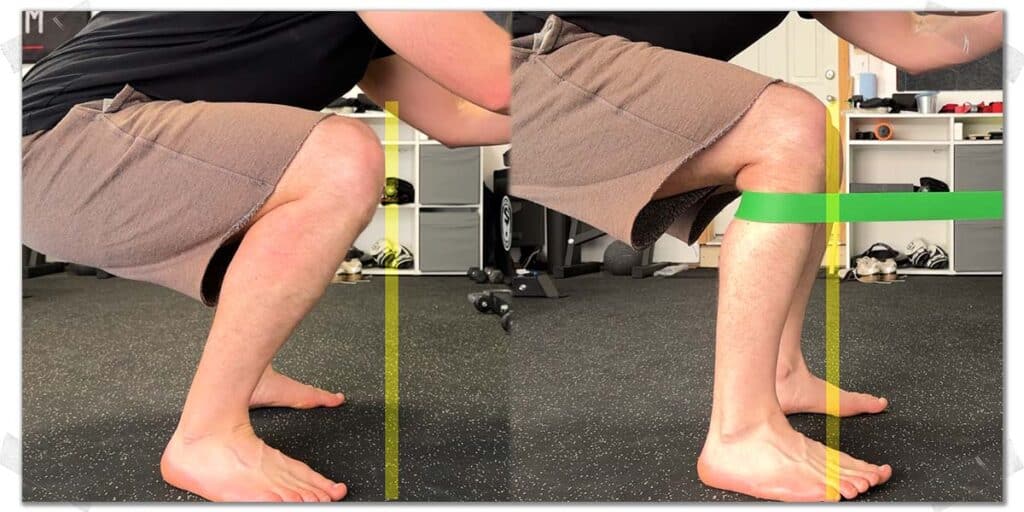
And that’s because if we want to remain upright with a free-standing squat, we need to have our center of gravity beneath our feet. Move this center of gravity too far backwards, and we fall over.
So, with the band around our lower leg, we can now shift our center of gravity backwards. With this taking place, we now create a longer moment arm, or what we call joint torque, which is taking place around the knee.
And if you feel like this exercise might be a bit much for your knees to take, check out this article right here, where I show you an outstanding regression you can perform to make this less taxing on your tendons and knee joint itself.
This longer moment arm means that the tendons of your knees and your quadriceps muscles are experiencing much greater stress or demand as they work to hold you in the squat position. It’s the same as if you were to hold onto some weight and then raise your arm upwards with your elbow straight. This would produce a lot more torque on the shoulder muscles than if you were to do it with your elbow bent.
So, if we know how to take advantage of this phenomenon, we can use it to fine-tune the stress and strain we place on different structures, in this case, the tendons around the knee and the quadriceps themselves. As you’re about to find out, we often need stress and strain on unhealthy tendons to provide the signal to them that they need to get their act together and heal up, provided it’s the right amount.
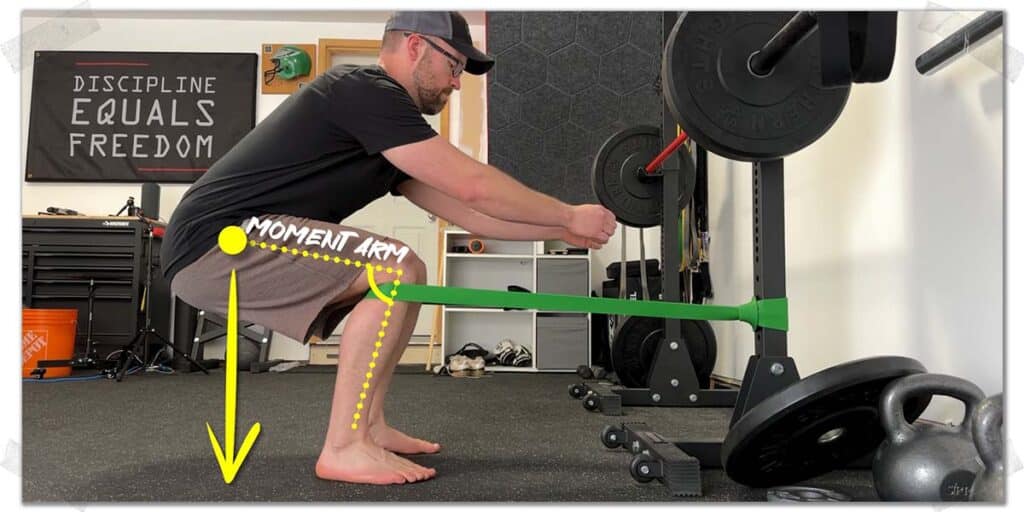
Speaking of bands, you can get these things just about anywhere these days, and then all you need is a sturdy object to loop and anchor the band to. From there, just step back to put some tension on the band, and you’re good to go!
If you need some bands, would like to save 10% on any purchases and would like to help support this channel, you can check out this link for a pack of bands from Animalhouse Fitness (their Buffalo Band pack). Purchasing from this link would provide me with a small commission at no extra cost to you and would help offset the cost of maintaining my website and other associated expenses to keep making content available to all of you.
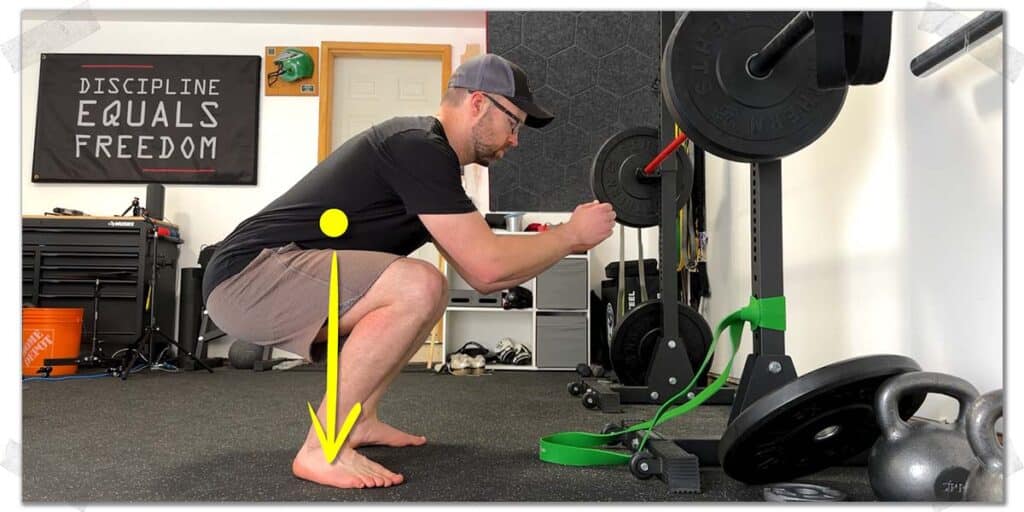
Now, while supporting my website and content creation pursuits is truly appreciated, I’m not here to be a salesman; just find a store or site that is selling these bands at a fair price, and you’ll have what you need.
Simplified: Regression to terminal knee extensions
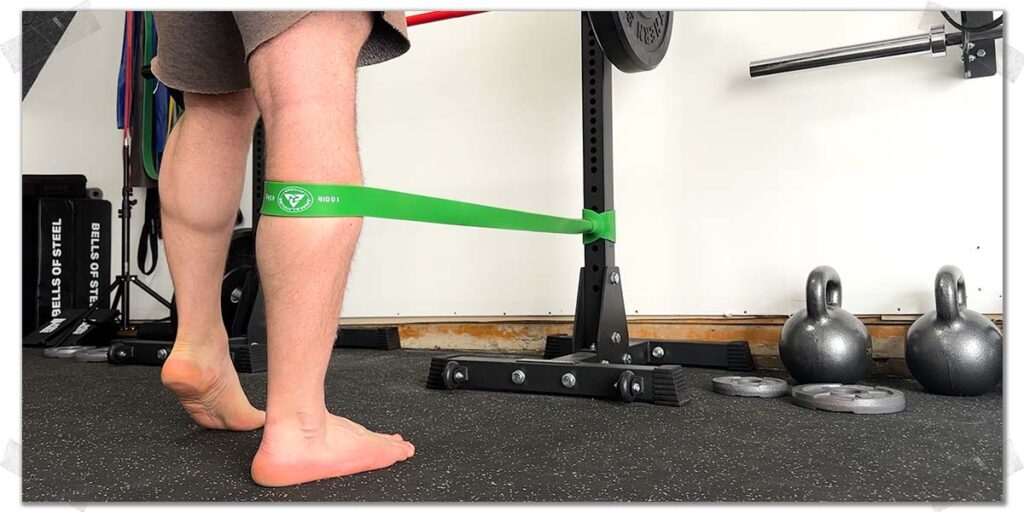
While some individuals might find value in the Spanish squat, it’s worth mentioning that it may be too challenging or pain-provoking for others.
If that’s the case, I’ve got you covered, as you can check out my article on how to perform a similar banded exercise that works to enhance something known as terminal knee extension.
This terminal knee extension drill is a fantastic exercise for all sorts of reasons, especially when it comes to rather painful knees that can’t tolerate the Spanish squat, so check out the article if you want to learn some seriously cool knee stuff, especially for knee rehabilitation!
Functionality: Translating to knee rehabilitation
The patellar tendon (technically called the patellar ligament) is one of the most commonly affected tendons in the body. It can become sore and painful, typically due to a lack of health.
The common quadriceps tendon, which sits just above the kneecap, can also become afflicted in the same manner, leaving it weak, painful, and unable to meet the demands of your physical activities or even daily lifestyle.
If these tendons become chronically unhealthy, it often leads to a condition called tendinosis. It’s very similar to the term you might be more familiar with, which is tendonitis. Now, bear with me here because I need to make the distinction between these two conditions as a means of helping you out as much as possible.
Related content:
Tendonitis refers to an inflammatory process that is actively taking place within a tendon. It tends to be prevalent either after a tendon has been repeatedly overworked or been exposed to a sudden trauma, which we call an acute injury. Tendonitis is typically present in the very early stages of the tendon becoming unhealthy, but as time progresses, this inflammatory process essentially stalls out, and you’re left with an unhealthy tendon that doesn’t have this inflammatory process taking place, and we call this tendinosis.
Tendinitis isn’t nearly as prevalent as we once believed it to be, and research has found that tendinosis is much more common.
When our tendon is stuck in this chronically unhealthy state, which my colleagues and I often call tendon purgatory, it won’t get much healthier without being stimulated or challenged appropriately. What these tendons need is the right amount of mechanical stress to initiate the recovery process.
What we’ve found through research is that the Spanish Squat creates a hefty amount of stress in these knee tendons, which we can fine-tune and then use to our advantage to foster this healing and recovery process. There are, of course, plenty of other outstanding exercises you can do to stimulate these tendons back to full health, but what’s nice is that the Spanish squat has been shown to change the biomechanics around the knee in a manner that ensures they’re getting a hefty stimulation.
The beauty with all of this is that you just need a large resistant band, which you can get just about anywhere these days, and a stationary object you can wrap it around. Squat racks work great for this, but if you’re outdoors, soccer posts, benches, and other common objects also work great.
Related article: Knee Pain From Leg Extensions: Why It Happens & How To Fix It
Optimal Parameters: Individualizing for YOUR needs
Alright, you now know about what the exercise does, but how do we make the most of it and get the most out of it?
Well, assuming that your patellar tendon and/or quadriceps tendon need to be stimulated, there are plenty of ways this can be done. Many folks will simply do some slow squats through a range that feels appropriate for them, which should be helpful to a certain extent.
But as I’ve really had my nose in the research with tendon rehab over the past couple of years, I often follow a different protocol. It’s not like these protocols are “right” or “wrong,” but perhaps more ideal based on specific circumstances.
But to be clear, an individualized approach based on your own situation will be best, so I always advocate that you work with a qualified healthcare professional who has assessed your situation. Still, for an otherwise “vanilla” presentation of knee tendinosis, here’s what I often do with my patients:
I tend to advocate for a 30-second isometric hold, meaning you’re forcing your muscles to hold you in the squat position. Hold as deep of as squat as you can as you want to tire yourself out as much as possible in this timespan, and then once you’ve completed your 30-second hold, immediately perform slow Spanish squats through a range that’s tolerable for you. You likely won’t have to go through as extensive of a range at this point as you did with your squat hold, but try to get what you can.
The goal here is to get to the point where you can perform these squats for a couple of minutes at a very slow pace. You may need to start out by taking little breaks here and there and perhaps only doing a minute of these squats, but the goal would be to get up to a couple of minutes’ worth of repetitions through an appropriate range of motion.
Please remember that I’m simplifying a lot of this due to the nature of it being a blog article for general audiences. If you do want to learn the hardcore geeky stuff, you can check out some great videos by folks such as Dr. Keith Baar and Dr. Jill Cook, as they’re gurus on this stuff. I love to geek out on these things but realize that a general audience might not want the hardcore stuff.
If you’re wondering why we start with the 30-second hold, it’s so that we tire out the healthy tendon fibers that protect the unhealthy fibers, preventing them from getting the stimulation they need. This phenomenon is called stress shielding, and taking this into account for tendon rehab is pretty important.
Expectations: What should you feel?
What’s critical to understand is that stimulating unhealthy tendons often causes discomfort, and in a typical case of patellar or quadriceps tendinosis, this is not a bad thing; we just don’t want pain. Discomfort is more of the “I feel this, but it’s not bad enough to make me want to stop.” Whereas pain is a “I want to stop right now” sensation.
If we get the challenge just right, we often see the discomfort die out or lessen during this stimulation session.
Related content:
If you don’t feel that you’ve tired out your knees or haven’t generated mild discomfort with tendon rehabilitation exercises, it might not be enough of a stimulus to get things healthy again. This is particularly true for the later stages of tendon rehab. Basically, in this case, you’ve underdosed the medicine that we’re giving your body as a means to heal.
It often takes some time and effort to find the right dosage for your knees. Depending on the severity of the tendinosis, it often takes weeks and months of this type of loading to bring the tendon back to full health, so keep this in mind.
How often you’ll need to perform an exercise like this to optimally stimulate your tendons will depend on numerous factors, which I can’t cover in this video. Some people will require two light stimulations per day; others will only be able to perform something like this once every other day or so, so consider working with a healthcare specialist to help fine-tune these parameters.
What about healthy knees?
The beauty of the Spanish squat is that it’s a great exercise for knee rehabilitation and prehabilitation, (prehabilitation is another term often used for injury prevention).
The stronger you can keep your quadriceps muscles and your knee tendons, the healthier they will be. It also serves as a great way to warm up and prepare your knees for an upcoming demanding workout session with exercises like heavy squats, lunges, sprints, and so on.
You can even hold onto some extra weight when performing this exercise if you need even more of a challenge for your quadriceps. Take some time to play around with things and find what works best for you.
Regardless of whether or not you hold onto any weight, try to utilize the largest possible range of motion you can when performing the Spanish squat.
Final thoughts
Now, if you think that’s some cool knee stuff worth knowing, wait until you check out this blog article right here, which will drop a few more knowledge bombs on how you can get the most out of reducing aches and pains while building a stronger body in the process.
And in the meantime, keep making great things happen!

Hi! I’m Jim Wittstrom, PT, DPT, CSCS, Pn1.
I am a physical therapist who is passionate about all things pertaining to strength & conditioning, human movement, injury prevention and rehabilitation. I created StrengthResurgence.com in order to help others become stronger and healthier. I also love helping aspiring students and therapists fulfill their dreams of becoming successful in school and within their clinical PT practice. Thanks for checking out my site!

